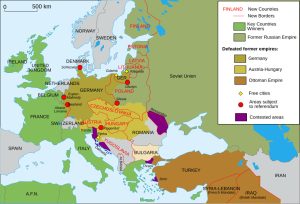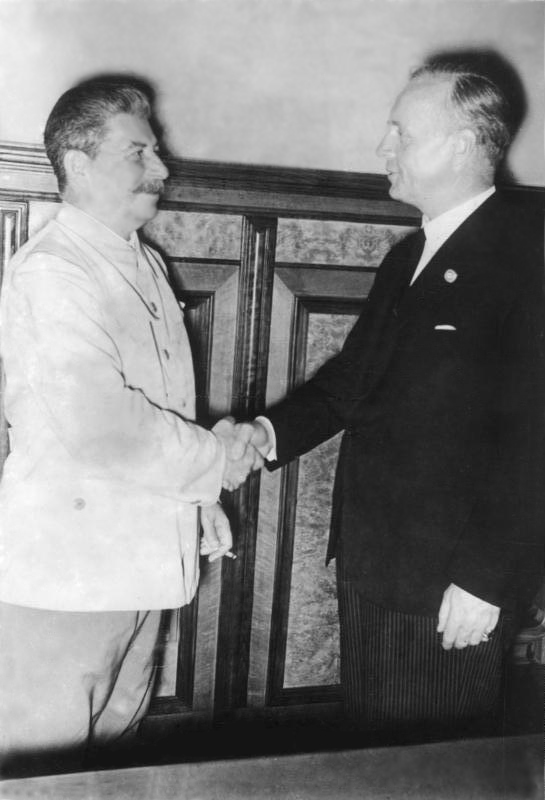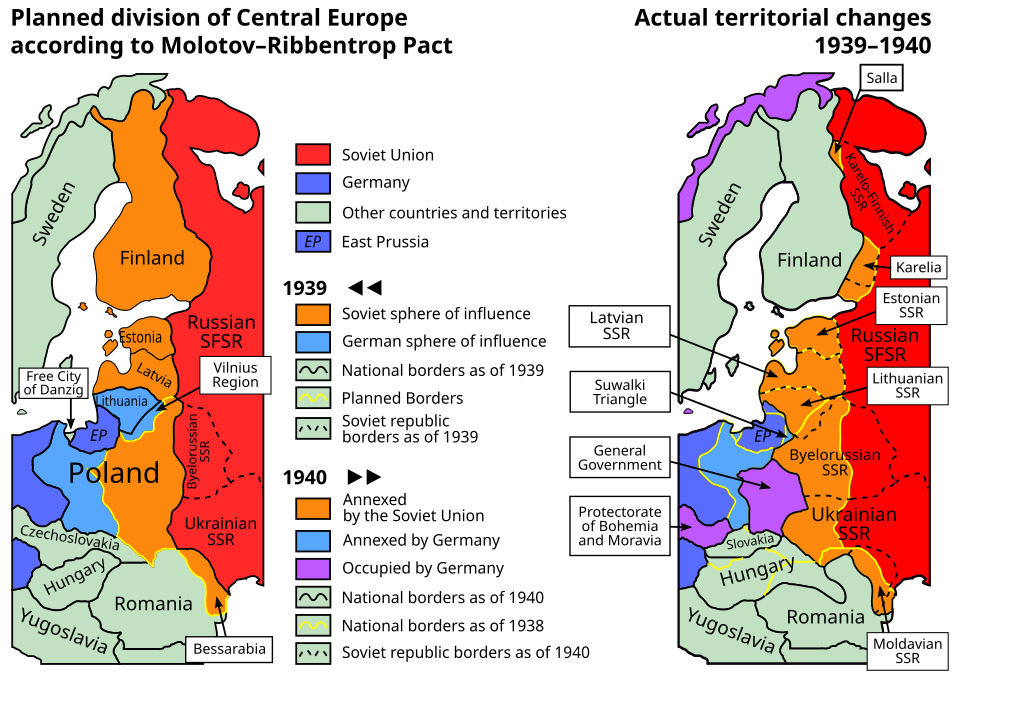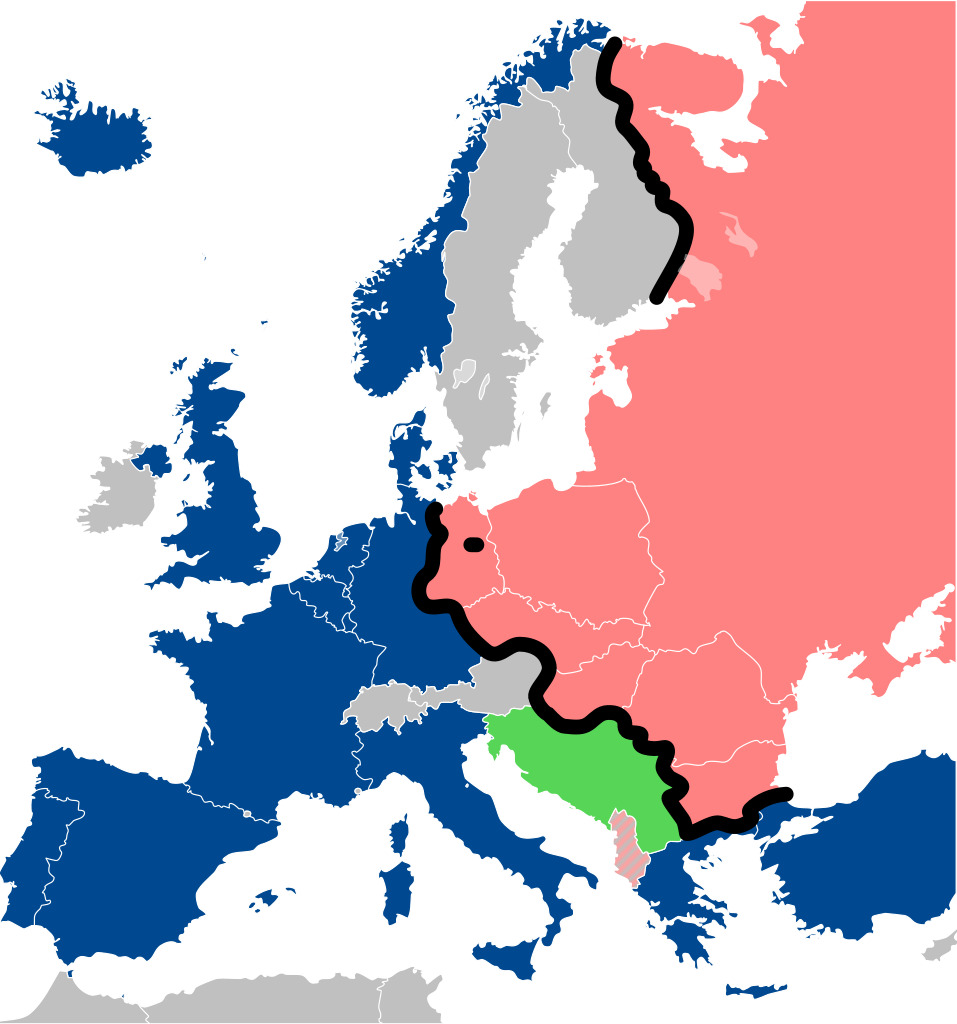On 23 August 1939 it was announced that Nazi Germany and the Soviet Union had signed a non-aggression treaty. The announcement was a complete surprise since Hitler had both in his writings and public speaking had denounced Communism and the Soviet Union. So why did this happen and what were its effects? Let’s find out.

Image via Wikimedia Commons
Both Germany and Russia had suffered in World War I. Germany was defeated by the Allies, lost its monarchy and colonial territories, and was ordered to pay huge reparations per the Versailles Treaty. Russia had gotten into the war to protect Serbia but was ill-equipped for a major war due to its limited resources and industrial capability. It suffered humiliating defeats during the war and its people suffered with reduced goods and services. This fed to unrest which led to Tsar Nicholas II to abdicate and allow a more democratic government to take over. Alas, that did not last as it continued in the war despite its unpopularity. This allowed the Communists, led by Lenin (who had been sent back to the country by Germany to foment chaos) to seize power and overturn the entire social and political structure of the country. In Germany, after a decade of vacillating leadership and discontent over inflation and Germany’s loss of status in the world, Adolf Hitler would lead the Nazi Party to victory after he was given the chancellorship in in 1933. Both Germany and Russia (now called the Union of Soviet Socialist Republics or just Soviet Union), were led by authoritarian governments that ruled with an iron fist.
The Soviet Union in its early days sought a promised world-wide revolution that never happened causing its leader Lenin and later Stalin to realize that building up the country first was needed before worldwide revolution. Hitler and the Nazi’s had a different view as they wanted to expand their country and restore pride in Germany. A new Germany was being formed with a clear ideology they were the people that would lead to change Europe and the world. By 1939, Germany was making its moves in Europe by invading Czechoslovakia. In 1938, they demanded and got a piece of Czechoslovakia when Britain and France, desperate to avoid war, forced Czechoslovakia to accept the deal breaking a treaty they had signed to defend it. Germany also annexed Austria that year as well uniting both countries. The invasion of Czechoslovakia told Britain and France that Hitler would not honor his agreements.
On the Russian side, Stalin had instituted programs to industrialize the country, but his brutal dictatorship had resulted in people being denounced, tried, and either imprisoned for years or executed. A climate of fear existed and not knowing whether someone had denounced you in secret made you wonder if you would come home that night. The Great Purge of 1936-1938 saw its officer corps depleted. The German Gestapo, feeding on Stalin’s paranoia, used the situation to use create documents that implicated many in the officer corps but also in government as well. The era became known for its show trials where the accused would be brought in, tried of a crime they didn’t commit, and faced imprisonment or death depending on the severity of the charge. Those who had become important members of government or close to Stalin that had been purged would be removed from the public record as well. Photos were retouched to show they were no longer walking, standing, or near Stalin or other people.
Stalin looked at expanding the Soviet Union by stealth or force into Europe. He hoped the war between the European nations would so weaken them so he could achieve his aims. Poland was, like Czechoslovakia a means to an end for both powers. Germany’s racial theory held the Polish people were, like the Jews, to be eliminated. For all the bad reasons, both Hitler and Stalin would come to terms and agree to a treaty that divided Poland into two spheres. Secret protocols to the pact indicated the demarcation lines and other things as well. The countries of Lithuania, Latvia, Estonia, Finland were secretly divided up as well giving both Germany and the Soviet Union access to raw materials. This allowed Hitler to invade Poland in September. Russia would move to claim its share of Poland, which the German military was not quite happy about since in some areas they had to withdraw back to the lines agreed to in the secret protocols.
“Nothing more unbelievable could be imagined. Astonishment and skepticism turned quickly to consternation and alarm”. (Gunther, John (1940). Inside Europe. New York: Harper & Brothers.)

Source: German Federal Archive
The news of the agreement, popularly called the Molotov-Ribbentrop Pact, stunned the world. No one expected that Hitler would make a deal with Stalin. There had been some leaks suggesting of it, but no one thought it credible this would occur. The British and French had been in negotiations with the Soviets for months and were blindsided. Soviet propaganda heralded the agreement while others questioned secret protocols that were signed. Italy and the U.S. were given some limited information about them, but the full details were not disclosed. Soviet propaganda downplayed the previous attacks on Germany and Molotov himself made it clear they harbored no ill will. Nazi propaganda also had to do an about face as well. The Nazi’s had shut down the German Communist Party, imprisoned its leaders, and shut down its press. And they had nothing good to say about the Soviet Union either. Now they had to say everything was good with the hated Communist state.
Meanwhile the Baltic States began to worry how the rumored secret protocols would soon impact them. British and French attempts to meet with the Soviet negotiator over the agreement were rebuffed. Hitler said that with the treaty in place Britain should recognize Germany’s claims over Poland since it changed the situation from that of World War I. Instead, and to the German leader’s surprise, Britain announced a defense pact with Poland on 25 August 1939. Needless to say, Poland now realized it was being divided up by the two powers and war was coming.

Author: Peter Hanula via Wikimedia Commons
The British and French governments had reached their end with Hitler; they no longer trusted him. In both countries the appeasement supporters diminished as reality set in that war was most certainly coming now with Germany. Neville Chamberlain, the chief supporter of the Munich Agreement a year before to avoid war, now realized his failure. He made it clear to Germany it would stand by Britain’s agreement to defend Poland. Hitler considered Chamberlain a fool and ordered the military to invade Poland as planned. The only question the Germans really had was whether those powers would do anything while they were attacking Poland. Both the British and French declared war on Germany when it invaded Poland on 1 September 1939 but took no immediate military action. It was a mistake that would prove costly for both countries later.
Aftermath
Stalin gambled that Hitler would focus on Europe and not on Russia. His goal was to build up the Soviet Union for war or to move in when his forces had subverted the country they wanted to take. Like many (including the German military high command) a two-front war was to be avoided. All of that went out of the window when Hitler decided he would invade Russia in 1941 under Operation Barbarossa. The goal of the operation was to remove and execute the leadership of Russia, take control of Russia, and make it a place for German resettlement. Stalin was not prepared for war and had discounted warnings Germany was about to invade as an attempt to get Russia to scuttle the treaty. Germany got the initial success and took territory easily defeating the military forces it encountered. However, they never took Moscow despite being twenty miles from it. And as time went on, faced more stiffer resistance and a military helped by American military equipment sent to help Russia defeat Hitler.
A vicious war broke out between the German and Russian forces creating now an Eastern Front that began to demand more resources than initially thought needed. The Soviet Union was getting supplies from the Allies using the dangerous North Atlantic to Murmansk route. And when the Allies landed in Europe in June 1944, this caused even more strain already on the limited resources Germany had. The Soviet troops started pushing back and ultimately forced Germany into retreat and ultimately to Berlin in 1945 where Hitler would commit suicide rather than be captured.
Stalin though did achieve his war aims in the end. Now with their troops in Poland and throughout Central Europe in countries they had liberated from Nazi rule, they would undermine the return of its former governments and subverted their political structure to ensure Communists would take charge. Albania, Bulgaria, Czechoslovakia, East Germany, Hungary, Poland, Romania and Yugoslavia all came to be controlled by the Soviet Union through governments that were installed and supported by them. It gave them access to sources of raw materials they had not had before and created a buffer around Russia. For people that had survived living under the yoke of Nazi controlled governments, it was simply swapping out one ideology for another with the same type of tyranny running things. Yugoslavia under Tito did break away from Moscow (he was fiercely independent but Communist) but that was about it.

Image: Sémhur via Wikimedia Commons
Until the fall of Communism began in 1991, these countries would remain either directly or indirectly controlled by Moscow through their governments. Some countries such as Czechoslovakia would break up (Czech Republic and Slovakia) after Communism ended. Yugoslavia would also break up as well into Bosnia, Croatia, Macedonia, Slovenia and the Federal Republic of Yugoslavia. Romania had the most violent uprising (Poland had strikes that forced out the Communists) that ended with its leader being executed in the end. East Germany would be unified with West Germany ending the separation that had begun in 1945.
Sources
The Editors of Encyclopaedia Britannica. (2024h, August 16). German-Soviet Nonaggression Pact | History, facts, & Significance. Encyclopedia Britannica. https://www.britannica.com/event/German-Soviet-Nonaggression-Pact
German-Soviet Pact. (n.d.). https://encyclopedia.ushmm.org/content/en/article/german-soviet-pact
Klein, C., & Klein, C. (2023, October 5). How a secret Hitler-Stalin pact set the stage for WWII. HISTORY. https://www.history.com/news/the-secret-hitler-stalin-nonagression-pact
Molotov-Ribbentrop Pact: Hitler, Stalin & WWII – HISTORY. (2022, November 15). Molotov-Ribbentrop Pact: Hitler, Stalin & WWII – HISTORY. HISTORY. https://www.history.com/topics/world-war-ii/molotov-ribbentrop-pact
Suggested Reading
Gunther, J. (1940). Inside Europe (Revised Edition 1940). Harper Brothers. (Original work published 1936)
Moorhouse, R. (2014). The Devils’ Alliance: Hitler’s Pact with Stalin, 1939-1941. Basic Books (AZ).
Pipes, R. (1995). Russia under the Bolshevik Regime. Vintage.
Pipes, R. (2001). Communism: A History. Random House Digital, Inc.
Read, A., & Fisher, D. (1989). The Deadly Embrace: Hitler, Stalin and the Nazi-Soviet Pact, 1939-1941. W. W. Norton.
Shirer, W. L. (2011). The Rise and Fall of the Third Reich: A History of Nazi Germany. Simon and Schuster.
Titanic News Channel is a participant in the Amazon Services LLC Associates Program, an affiliate advertising program designed to provide a means for sites to earn advertising fees by advertising and linking to Amazon.com.
